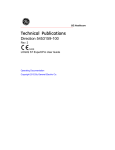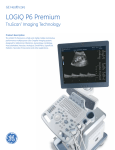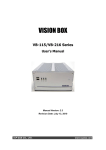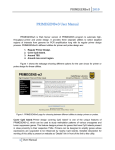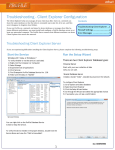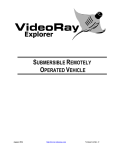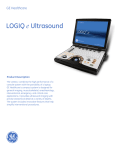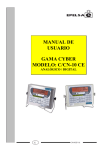Download Open
Transcript
PERFORM Operating Document Use and Maintenance of G.E. Ultrasound LOGIC E PC-POD-IM-001-v01 Revision History Version 01 Reason for Revision Date New POD 22/May/2013 Summary The content of this PERFORM Operating Document (POD) provides guidelines for the quality control, image acquisition, and maintenance of the G.E. Ultrasound LOGIC E. PC-POD-IM-001-v01 Printed copies are not controlled. Page 2 of 15 Table of Contents SUMMARY --------------------------------------------------------------------------------------------2 1. LIST OF ABBREVIATIONS -----------------------------------------------------------------4 2. INTRODUCTION -----------------------------------------------------------------------------5 2.1 OVERVIEW OF G.E. ULTRASOUND LOGIC E -----------------------------------------5 2.2 RESPONSIBILITY -------------------------------------------------------------------------------5 3. PROCEDURE ------------------------------------------------------------------------------------5 3.1 QUALIFICATION OF PERSONNEL -------------------------------------------------------5 3.2 TRAINING---------------------------------------------------------------------------------------5 3.3 OPERAITION -----------------------------------------------------------------------------------5 3.3.1 IMPORTANT SAFETY CONSIDERATION----------------------------------------------5 3.3.2 SYSTEM POWER -----------------------------------------------------------------------------6 3.3.3 STARTING AN EXAM ----------------------------------------------------------------------8 3.3.4 B/M MODE IMAGE OPTIMIZE ----------------------------------------------------------10 3.3.5 B MODE CONTROL PANEL CONTROLS -------------------------------------------11 3.3.6 COLOR FLOW/DOPPLER IMAGE OPTIMIZE----------------------------------------11 3.3.7 SCANNING HINTS ------------------------------------------------------------------------12 3.3.8 IMAGE MANAGEMENT-------------------------------------------------------------------14 APPENDIX I: Probe Immersion APPENDIX II: POD Training Record Form PC-POD-IM-001-v01 Printed copies are not controlled. Page 3 of 15 1. Definition of Terms ARDMS American Registry for Diagnostic Medical Sonography ATO Auto Tissue Optimization AVI Audio Video Interleave CAMRT A national certifying body for medical imaging technologist professionals CAO Chief Administration Officer CFM Color Flow Mode CWD Continuous Wave Doppler DICOM Digital Imaging and Communications in Medicine Diode Diode is a two-terminal electronic component with an asymmetric transfer characteristic LED Light Emitting Diode JPG Joint Photographic Experts Group Logic e LOGIC e Ultrasound brand from GE Healthcare MSK Musculoskeletal PDI Power Doppler Imaging PI Principal Investigator POD PERFORM Operating Document PRF Pules Repetition Frequency PWD Pulsed Wave Doppler PYROGEN Is a substance inducing fever ROI Region of Interest TGC Time Gain Compensation USB Is a data storage device that includes flash memory with an integrated Universal Serial Bus (USB) interface. PC-POD-IM-001-v01 Printed copies are not controlled. Page 4 of 15 2. Introduction This POD is designed to outline the use, maintenance and training needs for the G.E. Ultrasound LOGIC E. 2.1 Overview of G.E. Ultrasound LOGIC E An evolving technology with wide applications in imaging through medical/surgical and research practices such as Cardiac, Vascular, Neurological, MSK, OB/GYN, and Urology studies. 2.2 Responsibility It is the responsibility of all users and supervisor to ensure that this POD is followed. 3. Procedure 3.1 Qualification of Personnel Scans may be performed by a technologist (certified by ARDMS /CAMRT) or by a physician. Other research personnel performing ultrasound scans may do so after initial and ongoing training by a certified sonographer or physician and at the discretion of the principal investigator. 3.2 Training Basic theoretical training is a pre-requisite for any practical training. All users should receive proper training in applications and instrumentation. Users should never modify the equipment. 3.3 Operation 3.3.1 Important Safety Considerations The following topic headings (Participant Safety, and Equipment and Personnel Safety) are intended to make the equipment user aware of particular hazards associated with the use of this equipment and the extent to which injury can occur if precautions are not observed. CAUTION Improper use can result in serious injury. The user must be thoroughly familiar with the instructions and potential hazards involving ultrasound examination before attempting to use the device. Training assistance is available from GE Medical Systems if needed. The equipment user is obligated to be familiar with these concerns and avoid conditions that could result in injury. PC-POD-IM-001-v01 Printed copies are not controlled. Page 5 of 15 Incorrect Setting Equipment malfunction or incorrect settings can result in measurement errors or failure to detect details within the image. The equipment user must become thoroughly familiar with the equipment operation in order to optimize its performance and recognize possible malfunctions. 3.3.2 System Power Connect the system to the electrical supply and turn the power on. LED indicators, Indicates hard disk working status. When the LED is flashing, the system is writing or reading from the hard disk (Green). The orange LED will turn on when the battery is low. LOGIC e Control Panel Tour 1- TGC. Move slide pots left/right to adjust TGC. 2- New Patient. Press to activate these controls. 3- Additional Feature Keys: Steer, Harmonics, PDI. 4- Mode/Gain/Auto Keys: M Mode, Pulsed Wave Doppler (PW) Modes, Color Flow (CF) Mode and B Mode. Press these key to activate the mode; rotate the key to adjust the Gain; Press Auto to activate/deactivate auto optimization. 5- Imaging/Measurement Key: Cursor, Clear, Body Mark Measure, M/D Cursor, Scan Area, Set / B. Press these keys, as necessary. 6- Depth/Zoom/Ellipse. Adjust these keys, as necessary. 7- Start/Stop. 8- Print Keys: Press the P1, P2, P3 keys to archive, print, or send the image. 9- Freeze. Press Freeze to freeze the image or return to scanning. PC-POD-IM-001-v01 Printed copies are not controlled. Page 6 of 15 10- Keyboard. Use the keyboard to enter patient information and annotations. Press F1, F2, F3, F4, F5 and F12 keys to activate Online help/User Manual, Arrow, Eject, Spooler, Reverse and Touch Panel Mode On/Off functions. The User can define functions for the F6-F11 keys. The following functions are available for F7- F12 Keys: CWD, 3D, LOGIC View, CrossXBeam, ECG On/Off, Set Home, Text Overlay, Work Sheet, Grab Last, Word Delete and Video.DVR. Press [Utility] to enter the Utility function and configure the system. Press [Preset] to preset the system. Press [Report] to Enter the report page. LOGIC e Keys, Soft Menu Key Tour In general, there are two types of soft Menu keys: Paddle Switch and adjustable knobs. 1- The Paddle Switch is used to access and adjust the Sub Soft Menu. 2- Press the adjustable knobs to toggle option menu between line one and line two. 3- Rotate the adjustable knobs to adjust the corresponding parameters. Function Keys - Programmable Keys • F1 = Help (Enter Online Help / User Manual) • F2 = Arrow (Annotation Arrow) • F3 = Eject (Eject media) • F4 = Spooler (Activates DICOM Job Spooler screen) • F5 = Reverse • F6-F11 Programmable • F12 = Touch Panel Mode On/Off How to Program your programmable keys <Utility> - <Admin> - <Function Key>, <Key Configuration> then use the drop down menu. Choices for program Keys Shortcut keys • CWD • Ctrl + Alt + R: Restart the system • 3D • Ctrl + E: Eject • LOGIC View • Ctrl + Alt + V: Output Video PC-POD-IM-001-v01 Printed copies are not controlled. Page 7 of 15 • CrossXBeam • ECG On/Off • Set Home • Text Overlay • Grab Last • Word Delete • Video.DVR How to Program your hot keys <Utility> - <Admin> - <Function Key>, <Hot Key> then use the drop down menu. Choices for hot keys No function - Biopsy Guide - Save as - Active Image - Measurement Select - Auto Doppler Calculation - Auto Trace - DVD Format - Range Focus - OB Graph Measurement All Clear – ATO - Auto TGC - Print4 - Print5 3.3.3 Starting an Exam New Patient To start a new patient’s exam: 1. Press Patient. Press the New Patient button on the Patient menu. 2. Select the Exam Category. 3. Type the Patient ID, Patient Name, Birthdate, etc. 4. Press the Register button on the Patient menu (DO NOT press Register if you are automatically generating a patient ID). 5. Press B, Esc, or Exit. Patient Entry Menu Image Management Window [1] Access to this patient’s exam history and image management features. Function Selection Window [2] New Patient is used to clear the patient entry screen to input a new patient’s data into thedatabase. Register is used to enter new patient information into the database prior to the actual exam being performed. Details displays exam details and additional patient information. PC-POD-IM-001-v01 Printed copies are not controlled. Page 8 of 15 EZBackup, EZMove[3] One-step method to backup (move and delete p patient images) to an external media. Dataflow [4] Selects this exam’s dataflow preference. Exit [5] Exits the Patient Menu and returns to scanning. Patient Information [6] Patient ID, Name, Birthdate, Age and Sex. Category Selection and Exam Information [7&8] Select the appropriate category and enter the exam information. Patient View and Exam View [9] Patient View lists the patients in the database. “Search key” enables searching list by Patient ID, Last Name, First Name, Birthdate, Sex, Exam today, Exam between, Exam date before, Exam date, Exam date after, Accession Number and Exam Description. “string” field helps define the search parameters, and “Clear“ clears the searching condition. Exam View lists the exams of the selected patient. Select the patient or the exam in Patient View and press “Exam View”. PC-POD-IM-001-v01 Printed copies are not controlled. Page 9 of 15 3.3.4 B/M Mode Image Optimize Power Output Optimizes image quality and allows user to reduce beam intensity. 2% increments between 0-100%. Dynamic Range Dynamic Range controls how echo intensities are converted to shades of gray, thereby increasing the adjustable range of contrast. Focus Number and Position Increases the number of transmit focal zones or moves the focal zone(s) so that you can tighten up the beam for a specific area. A graphic caret corresponding to the focal zone position(s) appears on the right edge of the image. NOTE: Push key to toggle between Focus Number and Focus Position. NOTE: Not available when Auto frequency/Autodepth active. Rejection Selects a level below which echoes will not be amplified (an echo must have a certain minimum amplitude before it will be processed). Edge Enhance Edge Enhance brings out subtle tissue differences and boundaries by enhancing the gray scale differences corresponding to the edges of structures. Adjustments to M Mode's edge enhancement affects the M Mode only. Frame Average Temporal filter that averages frames together. This has the effect of presenting a smoother, softer image. Colorize Enables gray scale image colorization. To deactivate, reselect a Gray Map. Gray Map Determines how the echo intensity levels received are presented as shades of gray. Rotation (Up/Down) Rotates the image by selecting the value from the Soft key. PC-POD-IM-001-v01 Printed copies are not controlled. Page 10 of 15 Frequency Multi Frequency mode lets you downshift to the probe's next lower frequency or shift up to a higher frequency. Line density Optimizes B Mode frame rate or spatial resolution for the best possible image. 3.3.5 B Mode Control Panel Controls Auto Optimize Automatic Tissue Optimization optimizes the image based upon a specified Region of Interest (ROI) or anatomy within the display. Zoom Magnifies a zoom region of interest, which is magnified to approximately the size of a full-sized image. An un-zoomed reference image is displayed adjacent to the zoom window. The system adjusts all imaging parameters accordingly. Press Depth/ Zoom/Ellipse key to activate Zoom. Adjust the key to increase or decrease the zoom size. Use the Trackball to position the Zoom ROI. Only when the zoom size reaches the max or press the Depth/ Zoom/Ellipse key again would deactivate the Zoom, and activate Depth. Reverse Flips the image left/right. Range Focus Improves the near/mid field image quality, borders/ interfaces, increases contrast and detail resolution across the image, and allows for less filling in the vessels. 3.3.6 Color Flow/Doppler Image Optimize Baseline Adjusts the baseline to accommodate faster or slower blood flows to eliminate aliasing. PRF/Wall Filter Velocity scale determines pulse repetition frequency. If the sample volume gate range exceeds single gate PRF capability, the system automatically switches to high PRF mode. Multiple gates appear, and HPRF is indicated on the display. Wall Filter insulates the Doppler signal from excessive noise caused from vessel movement. NOTE: Push button to toggle between PRF and Wall Filter. PC-POD-IM-001-v01 Printed copies are not controlled. Page 11 of 15 Angle Correct Estimates the flow velocity in a direction at an angle to the Doppler vector by computing the angle between the Doppler vector and the flow to be measured. Quick Angle Quickly adjust the angle by 60 degrees. Threshold Threshold assigns the gray scale level at which color information stops. Doppler Display Formats Display layout can be preset to have B-Mode and Time-motion side-by-side or overunder. Sample Volume Gate Length Sizes the sample volume gate. Map Allows a specific color map to be selected. After a selection has been made, the color bar displays the resultant map. Packet Size Controls the number of samples gathered for a single color flow vector. Controls in Common with B Mode For more information on Focal Zone, Power Output, Frequency, Frame Average, Dynamic Range, Gray Map, and Colorize, refer to the B/M Mode Image Optimize section in this Quick Guide. 3.3.7 Scanning Hints Line Density. Trades frame rate for sensitivity and spatial resolution. If the frame rate is too slow, reduce the size of the region of interest, select a different line density setting, or reduce the packet size. Wall Filter. Affects low flow sensitivity versus motion artifact. To improve sensitivity: 1- Increase the Gain. 2- Decrease the PRF. PC-POD-IM-001-v01 Printed copies are not controlled. Page 12 of 15 3456789- Increase the Power Output. Adjust the Line Density. Decrease the Wall Filter. Increase Frame Average. Increase the Packet Size. Reduce the ROI to the smallest reasonable size. Position the Focal Zones properly. To decrease motion artifact: 1- Increase the PRF. 2- Increase the Wall Filter. To eliminate aliasing: 1- Increase the PRF. 2- Lower the Baseline. For venous imaging: 1- Ensure that you have selected the vascular exam category. 2- Select a venous application. 3- Select the appropriate probe for very superficial structure. 4- Select two focal zones. 5- Adjust the depth to the anatomy to be imaged. 6- Maintain a low gain setting for gray scale. 7- Activate Color Flow. 8- Maintain the PRF at a lower setting. 9- Increase Frame Averaging for more persistence. CFM Top/Sub Menu Controls PC-POD-IM-001-v01 PWD Top/Sub Menu Controls Printed copies are not controlled. Page 13 of 15 Probe Cleaning, After Each Use 1- Disconnect probe from ultrasound console and remove all coupling gel from probe by wiping with a soft cloth and rinsing with flowing water. 2- Wash the probe with mild soap in lukewarm water. Scrub the probe as needed using a soft sponge, gauze, or cloth to remove all visible residue from the probe surface. Prolonged soaking or scrubbing with a soft bristle brush (such as a toothbrush) may be necessary if material has dried onto the probe surface. 3- Rinse the probe with enough clean potable water to remove all visible soap residue. 4- Air dry or dry with a soft cloth. Probe Disinfection, After Each Use 1- Prepare the germicide solution according to the manufacturer's instructions. Be sure to follow all precautions for storage, use and disposal. 2- Place the cleaned and dried probe in contact with the germicide for the time specified by the germicide manufacturer. High-level disinfection is recommended for surface probes and is required for endocavitary and intraoperative probes 3- (follow the germicide manufacturer's recommended time). Probes for neuro surgical intra-operative use must NOT be sterilized with liquid chemical sterilants because of the possibility of neuro toxic residues remaining on the probe. Neurological procedures must be done with the use of legally marketed, sterile, pyrogen free probe sheaths. 4- After removing from the germicide, rinse the probe following the germicide manufacturer's rinsing instructions. Flush all visible germicide residue from the probe and allow to air dry (Appendix I). Probe Disinfection Agents Ultrasound probes can be disinfected using liquid chemical germicides. The level of disinfection is directly related to the duration of contact with the germicide. Increased contact time produces a higher level of disinfection. Review the probe care card that is packed with each probe. The following website contains the most current and up-to-date recommendations: http://www.gehealthcare.com/usen/ultrasound/ products/probe_case.html 3.3.8 Image Management Clipboard As images are saved by pressing any of the print keys (P1, P2, or P3), the images appear at the bottom of the display on the clipboard as thumbnails of the images saved during the exam. These images remain on the clipboard until the end of the exam. PC-POD-IM-001-v01 Printed copies are not controlled. Page 14 of 15 Printing Images Press the appropriate print key (P1, P2, P3). Browsing an Exam’s Stored Images From the New Patient menu, open Image History. View the thumbnail images for the past exam or group images. Managing an Exam’s Stored Images From the New Patient menu, open Active Images. View active exam images. Deleting an Image Select the image on the clipboard, then press the onscreen Delete shortcut or From the New Patient menu, select the image from the Review Screen of Image Management, then press Delete. Save Image to USB Memory Stick The brand validated is: 1- Kingston 512MB USB To use them the user needs to do the following: 2- Insert them into a free USB port. 3- Click on the Menu option from the right side of the screen. 4- Click Save As. 5- Select the Removable disk drive. 6- Select File Type (DICOM, JPG or AVI). 7- Provide File-Name and press Save. Note: Before pulling out the memory stick, the device should be stopped, by clicking on the EjectHardware Icon (see following figure), selecting the device, and pressing Stop. PC-POD-IM-001-v01 Printed copies are not controlled. Page 15 of 15 APPENDIX I Probe Immersion Levels PC-POD-IM-001-v01 Printed copies are not controlled. Page 16 of 15 Probe Immersion Levels 1. Fluid Level 2. Aperture 3. Contact face within patient environment CAUTION In order for liquid chemical germicides to be effective, all visible residue must be removed during the cleaning process. Thoroughly clean the probe, as described earlier before attempting disinfection. You MUST disconnect the probe from the LOGIC e prior to cleaning/disinfecting the probe. Failure to do so could damage the system. PC-POD-GA-001-v01 Printed copies are not controlled. ii APPENDIX II POD Training Record Form PC-POD-GA-001-v01 Printed copies are not controlled. ii POD Title Use and Maintenance of G.E. Ultrasound LOGIC E SOP Code Ownership Document type Area SOP Number Version PC POD IM 001 v01 Training Record Full Name Institution Contact (email or phone number) Signature Sign here PC-POD-GA-001-v01 Date Printed copies are not controlled. ii





















